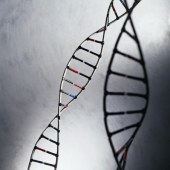
THURSDAY, July 29 (HealthDay News) — The genetic makeup of breast cancer tumors may be a better predictor of how well a woman will fare than a tumor’s size and appearance, which has been the traditional way of looking at cancers, new research suggests.
A European team of researchers analyzed the genetic makeup of 595 breast cancer tumors and compared the results to non-cancerous breast tissue. They then used algorithms to separate the tumors into eight types based on changes in the structure of the chromosomes, including deletions or amplifications of DNA, the study authors said.
In doing so, researchers showed that certain alterations in the patterns of DNA were able to predict cancer prognosis and response to particular treatments.
These findings join a host of recent scientific discoveries that suggest that the key to thwarting breast cancer may lie in the tumor’s DNA.
“Is this going to go into clinical practice tomorrow? No,” said Dr. Daniel Silver, assistant professor of medicine at the Dana-Farber Cancer Institute in Boston. “This is just one step of many toward a deeper understanding of breast cancer.”
The study was published in a recent issue of Science Translational Medicine.
Over the past few years, oncologists have increasingly relied on analyses of the DNA of breast cancer cells to determine which cancers are most likely to respond to certain treatments and which have the greatest chances of recurrence, explained Dr. Stephen Sener, past president of the American Cancer Society and a chief of the division of surgical oncology at the University of Southern California’s Keck School of Medicine.
“For many years, until about the turn of this century, breast cancer was thought to be one basic disease,” Sener said. “But since the human genome was elucidated, now people are working on the breast cancer genome. We’re learning a lot more about how cancers develop and how they behave.”
Instead of size, grade, number of lymph nodes impacted and other anatomical features of the tumor itself, many oncologists now peer at the genetic makeup of the tumor. Already, lab testing can show if cancer cells are estrogen receptor (ER) positive, meaning the cells use estrogen to promote their growth; progesterone receptor (PR) positive; hormone receptor negative or whether they have too many copies of the HER-2 gene, which promotes cell proliferation.
For each type, different medications may or may not work. For ER positive cancers, for example, drugs such as tamoxifen that block hormones can be effective, but would not work in women with hormone receptor negative cancers.
“There are some breast cancers that are very large that never spread. On the other hand, there are some patients who have very small cancers who have lots of lymph nodes involved,” Sener said. “Why are those patients different? What a lot us have realized is the standard anatomical descriptions of breast cancer is inadequate.”
DNA technology has already revolutionized oncologists’ treatment decisions, Sener said.
“This new way of looking at breast cancer genetic has allowed us to be much more focused about the prognosis, who will respond to chemo, hormones or both,” Sener said. “It’s really a major advance in breast cancer technology that has emerged in the last 3 to 5 years.”
“Eventually, the size of the tumor will probably be an irrelevant piece of information,” he said.
More information
There’s more on breast cancer at the American Cancer Society.

